Opal
Despite the many attributes often circulated concerning opal, one thing remains true: opal might be easy to damage and demanding to work with, but it is impossible not to be seduced by its sheer celebration of colour.
Unlike many other stones on this list opal is non-crystalline, but rather hardened silica gel containing somewhere between 5-10 percent water. Because of this there is always a risk that the stone may eventually dry out and crack.
There are two main varieties of opal: precious opal (which shows flashes of colour depending on the angle of viewing, an effect known as iridescence) and common opal (which is often opaque with no iridescence). The iridescence is caused by the arbitrary arrangement of tiny silica spheres which diffracts light. The larger the spheres, the greater the range of colours.
While most gemstones are cut or faceted to calibrated sizes and shapes, opals are frequently cut as cabochons with free-form shapes. The irregular shapes make each opal piece unique, allowing the stones to bring creativity to jewellery design.
There are many categories of opal ranging from the more precious white, black and jelly opal, to the more playful and bolder boulder, matrix, fire, harlequin, crystal and cat’s-eye opals. There are also more singular coloured opals available known as Andean, Ethiopian, honey, prase and seascape opals. Each type may differ in colour and patterns, but they all share the same hypnotic iridescence.
Sources:
Judith Crowe, The Jeweller's Directory of Gemstones (London: A&C Black, 2006)
Cally Hall, Gemstones (London: Dorling Kindersley, 1994)
Jaroslaw Bauer and Vladimir Bouska, A Guide in Colour to Precious & Semiprecious Stones (London: Octopus Books, 1983)
